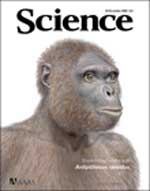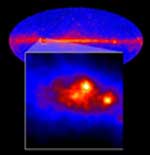
This month in Science Roundup:  Ardi Breaks Through Ardi Breaks ThroughSpecial Online Collection Each year, the editors and news staff of Science look back at the big science stories of the past 12 months, and dub one of them the Breakthrough of the Year. In 2009, the top prize went to Ardipithecus ramidus -- a 4.4-million-year-old skeleton unearthed in Ethiopia that sheds new light on the evolution of human limbs and locomotion, the habitats occupied by early hominids, and the nature of our last common ancestor with chimps. Other discoveries worthy of runner-up commendation included new gamma-ray observations, the long-sought receptor for a key plant hormone, magnetic monopoles, a drug that increases life span, ice on the moon, gene-therapy successes, insights into the properties of graphene, Hubble's rebirth, and the first x-ray laser. A review of last year's prediction for advances in 2009, the naming of H1N1 influenza as the "virus of the year", and a forecast of areas to watch in 2010 rounded out the special section. Online, Science Careers profiled two paleontologists involved in this year's Breakthrough achievement, a video highlighted the significance of the Ardipithecus findings, and a special edition of the podcast revisited the year's top science stories. Pleistocene Tidiness One aspect of human intelligence is the ability to organize our living and work spaces. It was generally thought that this capability arose with modern humans in the past 100,000 years or so. Now, a Report in the 18 Dec 2009 Science suggests that our ancestors started organizing their homes much earlier. Alperson-Afil et al. found evidence of domestic organization at Gesher Benot Ya'aqov, a 790,000-year-old site in northern Israel's Hula Valley. Analyses of the site indicate that the hominins that lived there carried out different activities in two distinct areas. Around patches of burnt debris -- indicative of a hearth -- the team found remains of a wide range of plant and animal foodstuffs, including fruits and seeds, as well as remnants of turtles and small and large mammals. Certain types of stone tools (made from basalt and limestone) appear to have been made around the hearths, where there was also evidence of nut roasting and consumption of crabs. A separate "activity area" at the site showed evidence of knapping of stone tools made from flint and food chopping. The team concludes that this division of living space into designated activity areas may be a sign of "sophisticated cognition" thought to be unique to Homo sapiens. A ScienceNOW story by M. Balter highlighted the findings.  A Plume Beneath Hawaii? A Plume Beneath Hawaii?Volcanic hot spots, such as the one that continues to build the Hawaiian islands, are thought to form by one of two mechanisms: Mantle plumes bringing hot, buoyant material to the surface from deep within the Earth's interior, or extensive processing of the upper mantle due to plate tectonics. In a Report in the 4 Dec 2009 Science, Wolfe et al. used an extensive array of ocean-bottom and land-based seismometers to reveal the structure of the mantle beneath Hawaii. Three-dimensional images of shear-wave velocity beneath the islands suggest that the Hawaiian hot spot is the result of an upwelling high-temperature plume from the lower mantle (see the accompanying News story by R.A. Kerr). The data indicate a hotter-than-average column of rock extending downward at least 1500 kilometers, and reveal a several-hundred-kilometer-wide region of low velocities beneath and southeast of Hawaii that is in agreement with the prediction from geodynamic models of a "pancake" of hot rock where a plume would spread outward after hitting the cold, rigid tectonic plate. Recognition by Simple Cipher Xanthomonas bacteria attack their plant hosts by delivering their own transcription activator-like (TAL) proteins into the plant cell nucleus. Once in the nucleus, so-called TAL effectors bind directly to DNA and alter the expression of host plant genes to promote infection. In the 11 Dec 2009 Science, two complementary studies (both published online 29 Oct) described how the target DNA specificity of these proteins is encoded (see the related Perspective by D.F. Voytas and J.K. Joung). The new work focuses on the TAL effector's central domain, which contains a variable number of typically 34–amino acid repeats. The repeat is highly conserved, except for two adjacent highly variable amino acid residues at positions 12 and 13. Both research teams deduced a simple code that relates each of these amino acid pairs to specific nucleotides in the target DNA. Moscou and Bogdanove broke the code computationally, by searching for nonrandom alignments between the variable diamino acids in the TAL effector and DNA sequences of target promoters. Boch et al. deduced the code through molecular genetic analyses of the interactions between AvrBs3 (the TAL effector of a Xanthomonas pathogen of pepper) and its target DNA sequence in the promoter of a AvrBs3-regulated pepper gene, followed by experimental validation. Given the modularity of the code, the team was also able to design artificial TAL effectors with new DNA binding specificities by shuffling the repeat domains -- a feat that may be useful for biotechnology applications. MicroRNAs and Disease Two Reports in Science this month highlighted the promise of modulating specific microRNAs from the treatment of a debilitating neurodegenerative disease and a chronic viral infection. -- Williams et al. (11 Dec 2009) found that a small noncoding RNA expressed in skeletal muscle, miR-206, promotes nerve-muscle interactions in response to motor neuron injury and slows the progression of the neurodegenerative disease amyotrophic lateral sclerosis (ALS) in mice. An accompanying Perspective by R.H. Brown noted that the findings "provide insight into the molecular basis of neuromuscular junction plasticity in the adult and also into determinants of rates of disease progression in motor neuron disease." -- Lanford et al. (published online 3 Dec 2009) reported that therapeutic silencing of a microRNA required for hepatitis C virus infection (miR-122) reduces disease symptoms in chimpanzees (see the related ScienceNOW story by M. Enserink). The team showed that treatment with a compound called SPC3649 -- a short piece of artificial DNA that blocks miR-122 -- lead to long-lasting suppression of hepatitis C infection with no evidence of viral resistance or side effects in the treated animals. Senior author Henrik Ørum discussed the work in a related podcast interview.  Carbon, Nitrogen, and Plant Diversity Carbon, Nitrogen, and Plant DiversityIncreased nitrogen deposition and rising atmospheric carbon dioxide levels are important components of global environmental change. In a Report in the 4 Dec 2009 Science Reich presented results of a long-term open-air field experiment aimed at assessing the impact of these factors on plant diversity. Grassland communities planted with 16 species were grown under various combinations of atmospheric carbon dioxide and nitrogen levels at a site in Minnesota. Over 10 years, elevated N reduced species richness by 16% under ambient carbon dioxide but by just 8% at elevated carbon dioxide concentrations. Given that both nitrogen and carbon dioxide are projected to increase globally, these results provide a pointer to the types of ecological change that could be expected, at least in relatively simple plant communities. An accompanying Perspective by S.L. Collins explained how the multiple effects of carbon dioxide and nitrogen on plant traits and soil resources can alter the competitive interactions among species. Unspoken Prejudice Nonverbal behavior is a powerful form of social influence. People can abstract accurate meaning from even very brief exposures to a facial expression or subtle body language. A new study by Weisbuch et al. in the 18 Dec 2009 Science now shows that such silent behaviors can transmit racial bias to observers. In particular, the team reports that in American society, negative nonverbal behaviors modeled by white individuals in popular media critically shapes white viewers' orientations toward black individuals. The researchers edited clips from 11 popular television shows, removing certain characters from a scene as well as the audio track, and asked a group of college students to rate how favorably the other characters in the scene treated the unseen character. For most shows, characters displayed more negative nonverbal behavior toward the shows' black characters than toward their white characters. Additional studies showed that exposure to this televised bias accounted in part for white viewers' own race bias, as assessed with reaction-time and self-report measures. A Perspective by J.F. Dovidio discussed the implications of these findings. Nascent Peptides Revealed Detailed analysis of protein translation and translocation requires the identification and structural analysis of intermediates involved in these processes. X-ray crystallographic snapshots of ribosomes, associated translation factors, and transfer RNA have enabled the reconstruction of dynamic aspects of protein translation. Now, two landmark studies in the 4 Dec 2009 issue (published online 29 Oct) have used cryo-electron microscopy to visualize nascent polypeptide chains in the ribosomal tunnel that affect either protein translocation across membranes or regulation of bacterial gene expression (see the Perspective by Kampmann and Blobel). Becker et al. described the structure of the protein-conducting channel protein Sec61 -- which is involved in translocating secretory proteins across or inserting integral membrane proteins into the endoplasmic reticulum in eukaryotic cells -- interacting with the ribosome and a nascent secretory protein signal sequence. The team found that a single copy of the trimeric Sec61 complex (as opposed to an oligomer) provides a conduit for the nascent polypeptide and that two loops in particular interact with ribosomal RNA and protein components near the tunnel exit. Seidelt et al. reported the visualization of a nascent peptide in the tunnel of a bacterial ribosome at 5.8 angstroms. This resolution allows analysis of the conformation and interactions of the nascent chain with surrounding nucleotides and ribosomal proteins. The researchers showed that nascent chains adopt distinct conformations within the ribosomal tunnel, which suggests a mechanism by which a peptide can induce translational stalling to regulate gene expression.  Microquasar Detection Microquasar DetectionMicroquasars are binary star systems in which a normal star sheds matter onto a neutron star or a black hole, generating x-ray radiation and jets of material moving at relativistic speeds. Despite their frequent outburst activity, microquasars have never been unambiguously detected emitting high-energy gamma rays -- until now. In the 11 Dec 2009 Science (published online 26 Nov 2009), Abdo et al. reported the detection of variable gamma-ray emission from the microquasar Cygnus X-3 using the Fermi Large Area Telescope. The gamma-ray flux is modulated by the 4.8-hour orbital period of Cygnus X-3, and its variation is correlated with the radio emission originating from the microquasar's relativistic jets. The gamma-ray emission probably originates from within the binary system, opening new areas in which to study the formation of relativistic jets. A related Perspective by G.F. Bignami discussed these findings as well as independent confirmation of gamma rays from Cygnus X-3 by the Italian Space Agency's AGILE telescope. Fast Spin Flips Quantum computation holds the promise of vastly improving the efficiency of traditional computers, but a number of experimental challenges must first be overcome. At the top of the list is the controlled manipulation of a qubit -- the basic building block of quantum information, which can be any two-level quantum mechanical system. Whether based on spin states or electrostatic charges, qubits can suffer unwanted coupling with the surrounding environment, which can lead to decoherence and degrade the information. This means that quantum computation requires manipulating qubits at a rate much faster than decoherence occurs. In a Report in the 11 Dec 2009 Science (published online 19 Nov), Fuchs et al. described an important step in this direction. The researchers used pulses of strong microwave magnetic field to probe the dynamics of single spins in a nitrogen vacancy center in diamond -- a nitrogen impurity next to a void in the diamond crystal lattice. Nitrogen vacancy centers are attractive candidates for storing and manipulating quantum information because they can be used at room temperature and stay operational for milliseconds at a time. The team observed extremely fast spin flips of less than a nanosecond, offering the possibility that up to a million operations could be performed on a single spin during its coherence time. An accompanying Perspective by Gerardot and Öhberg highlighted the study.
|

